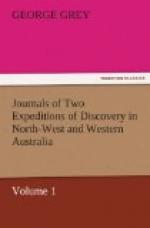FORD THE GLENELG. ANOTHER RIVER.
After breakfast we continued our route through a barren, sandy district, heavily timbered; and in the course of the afternoon met either the Glenelg or a very considerable branch of that stream in south latitude 15 degrees 56 minutes, east longitude 125 degrees 8 minutes: it was 250 yards across and formed a series of rapids at this point, where it emerged from a rocky gorge. Just above the rapids we found a good ford, the average depth of which was not more than three feet. After crossing, the banks on the other side were clothed with a species of Casuarina which I did not observe elsewhere. The country on that side of the stream was sandy and, as I found by the time we had proceeded two or three miles that we were getting embarrassed in a sandstone range, I halted the party for the night and went on to try if I could find a pass across it. My exertions were not however very successful: I came upon a path which I thought might be rendered practicable for the ponies over the first part of the range, but found no line by which we could proceed without making a road.
WEAKNESS OF THE MEN.
March 29.
At dawn this morning the men were at work forming the road; the poor fellows were however so much enfeebled from constant fatigue and very inefficient nutriment, whilst exposed to the great heat of a tropical climate, that they were unable to exert the same energy as formerly, and I could not but be struck with the great difference in their strength as evinced in their incapacity to move stones and other obstacles, which a few weeks ago they would have had little difficulty in lifting. The path was however soon made as passable as our abilities permitted, and we started along it with the ponies; some of them were however no less reduced than the men and, in endeavouring to lead one of them up a rocky hill, it fell, and from weakness sank under its light load without making an effort to save itself; the spine was thus so severely injured as to render it unable to move the hinder extremities; we therefore killed the poor creature and moved on.
SANDSTONE CAVE.
Throughout the day we continued gradually the ascent of the range which we had yesterday commenced. The large valley we were in led us by a gentle slope winding higher and higher amongst the rocky hills; at first it had been so wide as to appear like a plain, but by degrees it contracted its dimensions, until, towards the afternoon, it suddenly assumed almost the character of a gorge. Just at this point we saw in the cliffs on our left hand a cave, which I entered in the hope of finding native paintings.
Nor was I disappointed for it contained several of a very curious character. This cave was a natural chasm in the sandstone rocks, elevated at its entrance several feet above the level of the ground, from which the ascent to it was by a natural flight of sandstone steps, irregular, of course, but formed of successive thin strata, resting one upon another, and thus constituting an easy ascent; these successive layers continued into the body of the cave, quite to the end, where was a central slab, more elevated than the others, and on each side of this two other larger ones which reached the top of the cave and partly served to support the immense sandstone slab that formed the roof.




